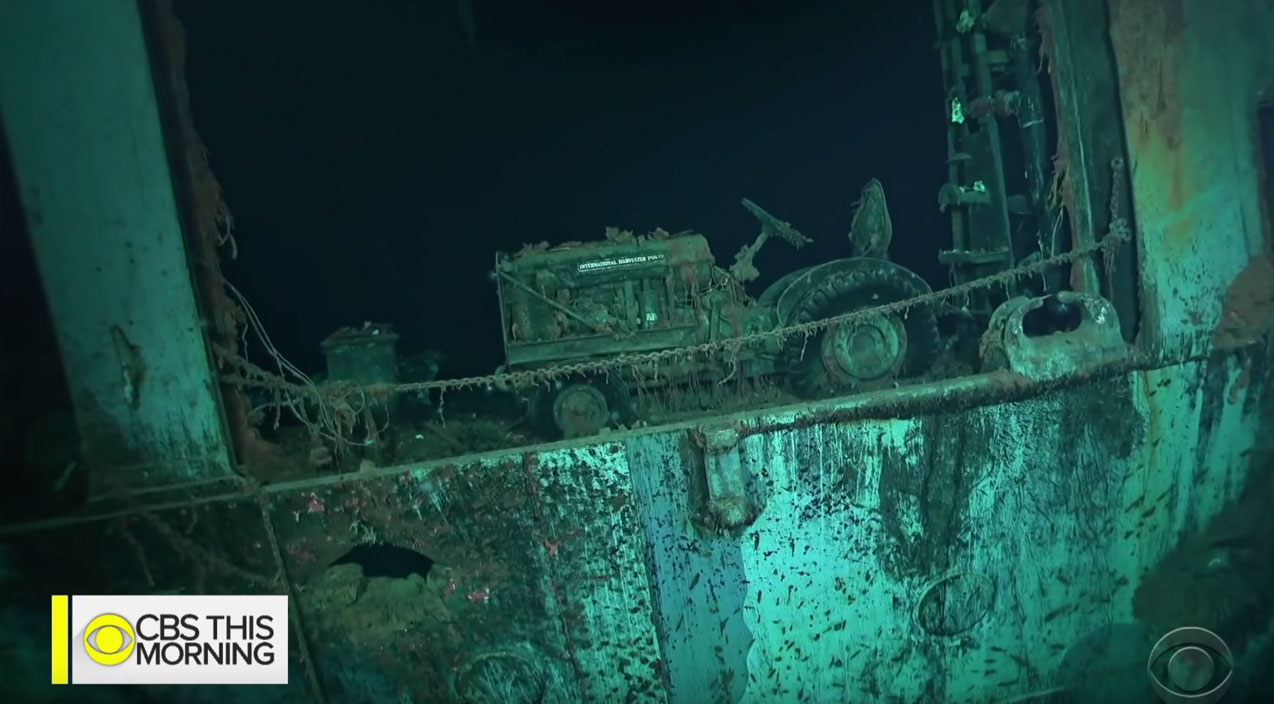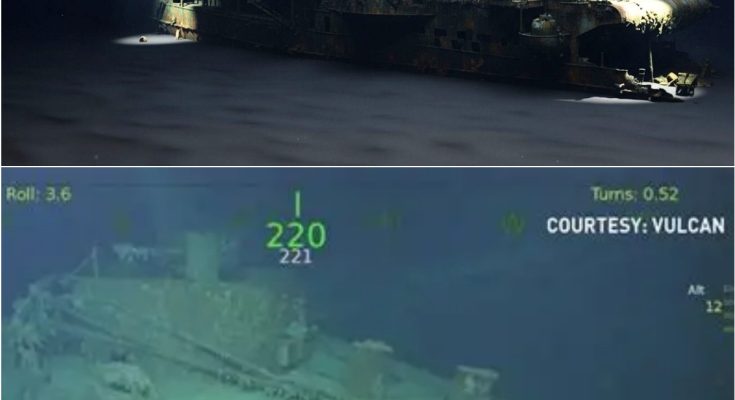
“17,000 Feet Under: The Lost WWII Carrier USS Hornet Has Been Found — But the Secrets Resting Beside Her Weren’t in Any History Book 🕯️💀”
It began quietly, with a sonar ping.

In early 2019, the research vessel Petrel, funded by the late Microsoft co-founder Paul Allen, launched an expedition into one of the most remote corners of the Pacific.
Their target: the final resting place of the USS Hornet (CV-8), the aircraft carrier best known for launching the daring Doolittle Raid on Tokyo in 1942 and later fighting in the Battle of Midway.
Few believed they would find her.
The Pacific is vast, its floor deeper than Everest is tall.
But after weeks of searching, the sonar returned an echo — a shape so massive it could only be a ship.
When the team lowered their underwater drone into the dark, frozen depths, it traveled down through a realm few human eyes had ever seen.
At 17,400 feet, light disappears completely.

Pressure could crush steel like paper.
Yet through the inky blackness, a silhouette emerged — long, ghostly, unmistakable.
“There she is,” one of the crew whispered, as the monitor flickered to life.
The Hornet.
After seventy-seven years, she had been found.
The first images stunned the world.
The ship lay upright on the seabed, her flight deck still recognizable, her hull draped in silt and marine snow.

Her nameplate, HORNET, was eerily intact, the letters untouched by time.
Around her, the scattered remains of aircraft — twisted Avengers and Dauntless dive-bombers — rested like sleeping birds.
The sea had claimed her, but not destroyed her.
But it was what they found inside the wreck that froze the room in silence.
The drone’s lights pierced a corridor leading into the interior of the ship.
Against all odds, certain compartments were sealed enough to preserve artifacts almost as they had been in 1942.
Coffee cups still sat in racks.
Boots lay neatly by bunks.
And on a control panel near the bridge, one dial was still faintly pointing to “BATTLE STATIONS.
“It felt like time had stopped,” said lead engineer Robert Kraft, who oversaw the drone’s descent.
“Like the ship was waiting.

One camera panned across the starboard side, revealing a massive gash torn through the hull — the wound that had doomed her.
On October 26, 1942, during the Battle of the Santa Cruz Islands, Japanese dive bombers and torpedoes struck the Hornet repeatedly.
She burned for hours before her crew abandoned ship, and U.S.forces were forced to scuttle her to keep her from enemy hands.
More than a hundred sailors died that day.
As the drone glided past the wreckage, one of the operators noticed something strange — a formation of objects scattered just beyond the hull.
When the lights swept across them, the shapes became clear: helmets.
Tools.A single dented lunchbox.
And then, at the edge of the camera’s range, the pale outline of a human shape — preserved by the cold, undisturbed waters of the deep.
The remains of a sailor who never escaped.

The control room aboard the Petrel went silent.
No one spoke for nearly a minute.
“It’s not just a ship,” one historian murmured.
“It’s a grave.
What shocked experts wasn’t simply the level of preservation — it was the emotional gravity of the site.
Unlike most wrecks, the Hornet looked almost ready to rise again, her decks eerily clear, her guns still pointed skyward.
One aircraft, a Douglas SBD Dauntless, sat on the edge of the flight deck as if waiting for orders that never came.
Its wings were still folded neatly.
Inside the cockpit, the control stick remained gripped — by a skeletal hand.
Historians were quick to note that this find wasn’t merely a relic — it was a moment frozen in time, capturing the precise instant before the ship’s final descent.
Forensic imaging confirmed that certain gauges and navigation tools were still set to their wartime configurations.

Incredibly, the damage on the ship matched the last eyewitness accounts from crewmen who had survived.
The discovery provided closure to the families of the fallen.
But it also reignited old mysteries.
Among the ship’s compartments, the drone’s sonar picked up a sealed room deep in the stern — one that didn’t match the ship’s schematics.
Engineers speculated it could be a cargo hold or an engineering compartment sealed off during the attack.
Plans are underway to revisit the site with upgraded drones capable of entering the sealed chamber.
For now, the location of the wreck remains classified — not to keep it secret, but to protect it.
The U.
S.
Navy officially recognizes the Hornet as a war grave.
No salvage, no intrusion, no disturbance.
Just silence.
The discovery sent ripples through the world’s naval community.
For some, it was a triumph of technology and history — proof that the ocean, though vast, could not keep her secrets forever.
For others, it was a haunting reminder of the cost of war.
“The Hornet was more than steel and bolts,” said one former Navy officer.
“She was courage.
And she still stands for it.
”
As the drone rose back through the darkness, the last images transmitted showed the ship’s nameplate once more.
The letters shimmered faintly in the beam of artificial light, then faded into black.
Seventeen thousand feet below the waves, the USS Hornet rests in eternal silence — a guardian of her own ghosts, a cathedral of sacrifice, untouched by time.
And perhaps, as some of the crew whispered when the lights dimmed in the control room, she’s still standing watch — waiting for her sailors to come home.
⚓🌊



